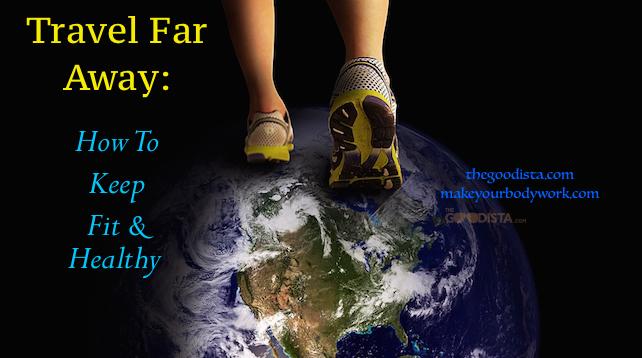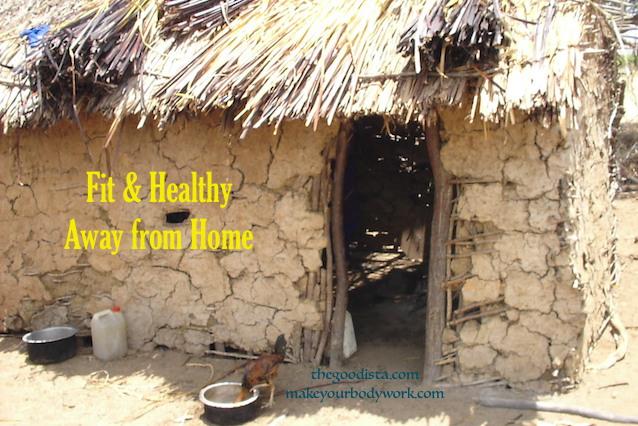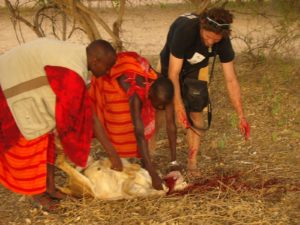 Travel fitness can be a challenge when you are away for a month or more. How do you maintain physical fitness and healthy living if you don’t have access to a gym, green smoothies and take-away salads? Our top fitness expert Dave Smith is back with travel tips on how to keep fit and keep tabs on nutrition. A month in Tanzania with the Maasai got him thinking. His concern before he travelled was how to maintain his fitness levels. He came back fitter than ever, and 15 lbs lighter. This post is a must-read for anyone who is going off the beaten track. If you are an intrepid traveller, humanitarian aid worker and/or contractor – this is for you. Keep tabs, track yourself and let us know how you keep fit away from home. Follow The GOODista for more field focused wellness inspiration.
Travel fitness can be a challenge when you are away for a month or more. How do you maintain physical fitness and healthy living if you don’t have access to a gym, green smoothies and take-away salads? Our top fitness expert Dave Smith is back with travel tips on how to keep fit and keep tabs on nutrition. A month in Tanzania with the Maasai got him thinking. His concern before he travelled was how to maintain his fitness levels. He came back fitter than ever, and 15 lbs lighter. This post is a must-read for anyone who is going off the beaten track. If you are an intrepid traveller, humanitarian aid worker and/or contractor – this is for you. Keep tabs, track yourself and let us know how you keep fit away from home. Follow The GOODista for more field focused wellness inspiration.
Travel Fitness : How to Keep Fit and Healthy by Dave Smith
For the past 15 years, keeping in tip-top shape has been a real priority for me. I love the feeling of accomplishment after completing a challenging workout, and I find it so exciting to get a little stronger, or to become a bit faster, or to be able to do a tiny bit more.
Fitness can be addictive that way. Once you get hooked, it can be so hard to stop.
 That’s why I was nervous when a mission trip had me leaving for the Maasai land of Tanzania. For nearly a month I would be without my beloved gym. There would be no pool for me to swim laps in. And who knew what sort of food would be available. Green protein smoothies for breakfast? Unlikely.
That’s why I was nervous when a mission trip had me leaving for the Maasai land of Tanzania. For nearly a month I would be without my beloved gym. There would be no pool for me to swim laps in. And who knew what sort of food would be available. Green protein smoothies for breakfast? Unlikely.
Maybe you’ve had a similar experience?
While it’s great to value physical fitness and healthy living, is there really reason to be concerned about taking time off while traveling? How much time off is too much? And what can you do to prevent any noticeable digression?
Let’s answer some of those questions.
How Fast Do You Lose Your Fitness?
Have you ever noticed how long it takes to make big strides in terms of fitness, and then how quickly those improvements can vanish?
One study showed that the initial drop-off in fitness is quite steep during the first week or two of inactivity. Participants actually lost 7% of their aerobic capacity after going just 12 days without training. Yikes!
But there is some better news: Studies have shown that the initial drop in fitness ends quickly.
The first two weeks of inactivity create the most noticeable losses, and then things begin to level out. Yes, your fitness will continue to decline if you aren’t active, but it will be at a much slower pace after the first two weeks.
How Much Exercise Do You Need To “Maintain” What You’ve Got
While it might be depressing to learn that even a week or two away from exercise will cause your body to back-slide, it’s important to note that you can easily prevent this from happening with just a little effort.
Another research study chose physically fit participants and had them follow a regimented exercise schedule for the next 32 weeks. Guess what happened? They all got in even better shape!
But then a simple change was made: The researchers abruptly cut their exercise time to just one single workout per week and enforced this rule for the following 16 weeks.
I know what you might be thinking: “One workout isn’t going to make a difference – They’re all going to get out of shape!” (That’s what I thought too)
After 16 weeks the researchers re-tested the fitness levels of the participants and concluded that their improvements were “largely maintained” even though they had been barely exercising at all!
What Does This Mean For You?
There are two important takeaways from these studies:
1) Avoid an “all or nothing” mentality
When I first decided to travel to Tanzania I thought my exercise routine was going to come to a screeching halt just because I couldn’t exercise the way I was used to exercising.
“I can’t do what I normally do so I guess the time away is going to be a write-off.”
Don’t fall for this faulty logic.
Instead of giving up on my workouts I researched all sorts of routines I could do without any equipment, and surprisingly I love the change!
In fact, I enjoyed bodyweight resistance training so much that I began passing these equipment-free workouts onto my clients when I returned home. If I could exercise in the Tanzania desert then my clients certainly could do the same wherever they were headed on vacation!
Here’s just one of the workouts I created. This is called “Sun Salutation” because, as you will see, it steals a number of yoga movements by the same name.
On my blog I post 2 new workouts each week. Each workout takes about 40 minutes to complete and can be done anywhere you go. The GOODista Top Tip: Get Dave’s blog earmarked and bring it with you!
Maybe this style of workout isn’t for you – that’s okay. How can you stay active while away from home?
Can you walk? Run? Swim? Bike? Do yoga? Go canoeing? Find a hiking trail? Or do something else that will help you avoid that “all or nothing” mindset?
2) It doesn’t take much
Similar to the “all or nothing” mindset, it is easy to think that doing a little exercise isn’t worth the effort or that it won’t make a difference. Yes, it will!
As we learned from the research study mentioned earlier, doing even 1/3 of your typical weekly exercise can help you maintain your fitness for quite a long period of time.
How many hours do you spend exercising while at home? Do you think you could find time for even 1/3 of that while you travel?
 In Tanzania I set a goal of exercising every other day. To a fitness nut like myself, this seemed like a big step backwards, but I had to adjust my mentality.
In Tanzania I set a goal of exercising every other day. To a fitness nut like myself, this seemed like a big step backwards, but I had to adjust my mentality.
“I don’t need to make progress during my time away. Instead, what can I reasonably do to keep the results I’ve worked so hard for?”
Travelling is a challenge because there is so much potential to have your typical routine thrown off. You will likely sleep at different time, eat at different times, and work at different times. That means your exercise may have to happen at different times as well.
Ask yourself, “How much exercise can I reasonably commit to while I’m gone?”
And remember that it’s okay if the answer seems small because it doesn’t take much to maintain your fitness.
How Can You Keep A Healthy Diet While Working Abroad?
Perhaps even more concerning than my time away from the gym was the questionable diet I would have to endure while living in the Tanzanian desert. I have a very regimented eating routine and I don’t like messing with it.
I was in for a bit of a shock.
When we arrived at camp our interpreter told us that the Maasai people were going to put on a feast because the people were so happy to have us there. This was music to me ears – Six hours sitting in the back of a pick-up truck as we entered the desert has left me famished.
The “feast” wasn’t what I had expected. The Maasai graciously offered us a little rice along with some boiled goat meat. It was a thoughtful gesture, but didn’t do much to satisfy my hunger.
Luckily I had come prepared. I had a batch of homemade protein bites along with a small jar of Greens+ powder. While not anywhere close to my typical diet, I knew these two items would provide calories, protein, and veggies if I were ever in a pinch. The GOODista Tip Read: 10 Food Fitness For Work (far) Away
My personal food supply didn’t last the entire trip, and I did end up eating a lot of foods that I wouldn’t choose at home. But, I also came to realize that a “healthy diet” may look  different depending on where you are and who you are with.
different depending on where you are and who you are with.
At home I try to eat mostly vegetables, with some protein at each meal, and a little fruit and grains. No processed foods and no sugar. There are few spots in the world where a similar diet can’t be followed.
Sure, the vegetables may be different (I ate a lot of plant-based soup while with the Maasai but I’m not sure I could identify any of the plant ingredients!), and protein may be a little scarce (ahem, boiled goat), but if you’re willing to be adventurous it’s likely that you will find some very healthy meals wherever you go.
Again, ask yourself a few questions to frame how you will approach your trip from a nutritional standpoint:
“What do I consider “healthy eating”? Can I get those types of meals while I’m gone? If not, what can I bring with me to supplement my diet abroad?”
If you’ve never visited your destination before this will require some research. Find out what foods they typically eat and how much food is readily available.
A Few Final Thoughts
When I arrived home from Tanzania everyone I ran into for the next week or so said the same thing: “You’re so skinny!”
(This isn’t a welcomed response when for someone who is natural bean pole!)
In four weeks I had lost almost 15 lbs ! The portions of food were just smaller than what I was used to, and life there was so physically demanding that it was hard to keep weight on.
My first few trips to the gym were what I expected. I was a bit weaker and my endurance wasn’t at its best, but these returned very quickly. Within a week or two I felt just as good as before I had left.
The same will be true for you. Plan ahead, commit to staying active (even it’s just a little bit each week), and search out some new healthy foods that you may not have tried before. These simple steps will keep your fitness on track no matter where in the world you are travelling.
Author Bio: Dave Smith is a professional fitness and weight loss coach who was chosen as “Canada’s Top Fitness Professional” by CanFitPro in 2013. You can learn more about Dave and his services at makeyourbodywork.com.
The GOODista team is so grateful to Dave for his personal story, tips and useful hints. Travel is about getting to know the world, and in the process you find yourself too. Being prepared helps you cope. Realising that things will not be the same, or even remotely like at home, is a way of finding alternatives. Travelling means living, seeing and exploring your inner self. Travelling allows you to mix the best of what you know from home with the new that is offered. For more inspirational posts about life and work away — far away — from home read The GOODista. Feel free to sign up to our newsletter here below.
Related and Recommended:
- The Field Mission Dilemma – The GOODista
- Advice for Travelling to Remote Locations – patient UK
- Staying Fit While Travelling Remotely – All-Species Fitness
- Make Your Body Work – Dave Smith’s website
`Are Keeping Fit When Away From Home? Comment:





















Very useful article!
Thanks, Ben! Really appreciate you taking the time to comment, and hope you will come back to The GOODista again. Cheers, A
Oh, this makes me long for the savannah and the Maasai! Having experienced them before, this post brings them out in a very positive way, thanks so much! And yes, planning ahead is always good,and certainly when going to far off and very foreign places. And then, it is good to adapt to the new environment and new foods. Just a matter of mindset!
Thanks for your comment. The GOODista team is so lucky to have guest bloggers like Dave Smith, who generously share their expertise, experiences and knowledge.